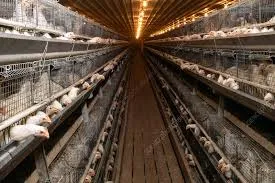Efficient Feeders for Poultry Cages to Enhance Livestock Nutrition and Growth
Dec . 16, 2024 20:15 Back to list
Efficient Feeders for Poultry Cages to Enhance Livestock Nutrition and Growth
Understanding Poultry Cage Feeders An Essential Component of Modern Poultry Farming
Poultry farming has evolved dramatically over the years, with advancements in technology and farming techniques leading the way. One of the crucial components that contribute significantly to the efficiency and productivity of poultry farming is the use of cage feeders. These feeders are an integral part of modern poultry operations, designed to optimize feed distribution and maintain the well-being of birds in a controlled environment.
What Are Poultry Cage Feeders?
Poultry cage feeders are specialized feeding devices used primarily in the rearing of chickens, ducks, geese, and other fowl. They are constructed to allow multiple birds to feed simultaneously while minimizing wastage and ensuring that each bird receives adequate nutrition. Typically made from materials such as metal or plastic, these feeders come in various designs that cater to the specific needs of different bird species and farming systems.
Types of Poultry Cage Feeders
There are several types of cage feeders available in the market, and each has its own set of advantages and disadvantages
1. Trough Feeders These are one of the most common types and consist of a long, open trough where feed is poured. Although they are easy to use and refill, they can lead to feed wastage as birds may scatter feed outside the trough.
2. Circular Feeders Designed to provide feed from a central hub, these feeders allow birds to access food from multiple angles. This design helps reduce waste and can support a larger number of birds at once.
3. Automatic Feeders These feeders use mechanical or electronic mechanisms to dispense feed at regular intervals. Automatic feeders offer convenience and efficiency, especially in large-scale operations, as they eliminate the need for manual feeding.
4. Manual Feeders While not as common in large commercial operations, manual feeders are still used in smaller farms. They require farmers to manually fill the feeders and monitor intake, which can be labor-intensive.
poultry cage feeders

Benefits of Using Cage Feeders
1. Reduced Feed Waste Cage feeders are designed to minimize feed spillage and waste, ensuring that the feed is directed primarily to the birds and not scattered across the floor.
2. Improved Hygiene By containing the feed in designated areas, cage feeders help maintain cleanliness and reduce the likelihood of feed contamination. This is particularly important in intensive farming where disease control is paramount.
3. Efficient Feeding The design of cage feeders allows birds to access feed more easily, which can lead to improved growth rates and better overall health. Birds are less likely to compete aggressively for food, reducing stress and fostering a more harmonious living environment.
4. Time-Saving Automatic and semi-automatic feeders help save time for farmers, allowing them to focus on other important aspects of farm management, such as bird health monitoring and overall farm operations.
5. Better Nutritional Management With precise feed delivery capabilities, farmers can ensure that their poultry receive the right amount of nutrients at the right time, ultimately improving productivity and profitability.
Challenges and Considerations
Despite their numerous advantages, poultry cage feeders also present certain challenges. One significant concern is the potential for feeder blockages, especially in automatic systems. Regular maintenance and monitoring are essential to prevent these issues and ensure a continuous supply of feed. Moreover, the initial investment in high-quality feeders can be significant, posing a financial challenge for some small-scale farmers.
Conclusion
Poultry cage feeders are a critical investment for any modern poultry farming operation. They not only enhance feeding efficiency but also play a crucial role in maintaining the health and welfare of birds. By understanding the different types of feeders and their associated benefits, poultry farmers can make informed decisions that will lead to enhanced productivity and profitability. As the industry continues to advance, the use of innovative feeding solutions will undoubtedly shape the future of poultry farming, making it more sustainable and efficient.
-
Automatic Feeding Line System Pan Feeder Nipple Drinker|Anping County Yize Metal Products Co., Ltd.
NewsJul.30,2025
-
Automatic Feeding Line System - Anping Yize|Pan Feeder,Nipple Drinker
NewsJul.30,2025
-
Automatic Feeding Line System - Anping County Yize Metal Products Co., Ltd.|Pan Feeder, Nipple Drinker
NewsJul.30,2025
-
Automatic Feeding Line System-Poultry Farming|Chicken Feeding&Watering
NewsJul.30,2025
-
Automatic Feeding Line System - Anping County Yize Metal Products Co., Ltd.|Pan Feeder Nipple Drinker,Broiler Farming
NewsJul.30,2025
-
Automatic Feeding Line System Pan Feeder Nipple Drinker-Anping County Yize Metal Products Co., Ltd.
NewsJul.30,2025






